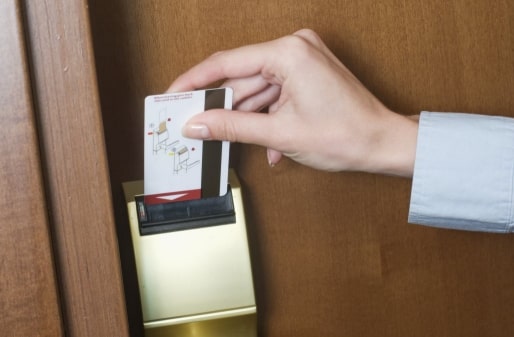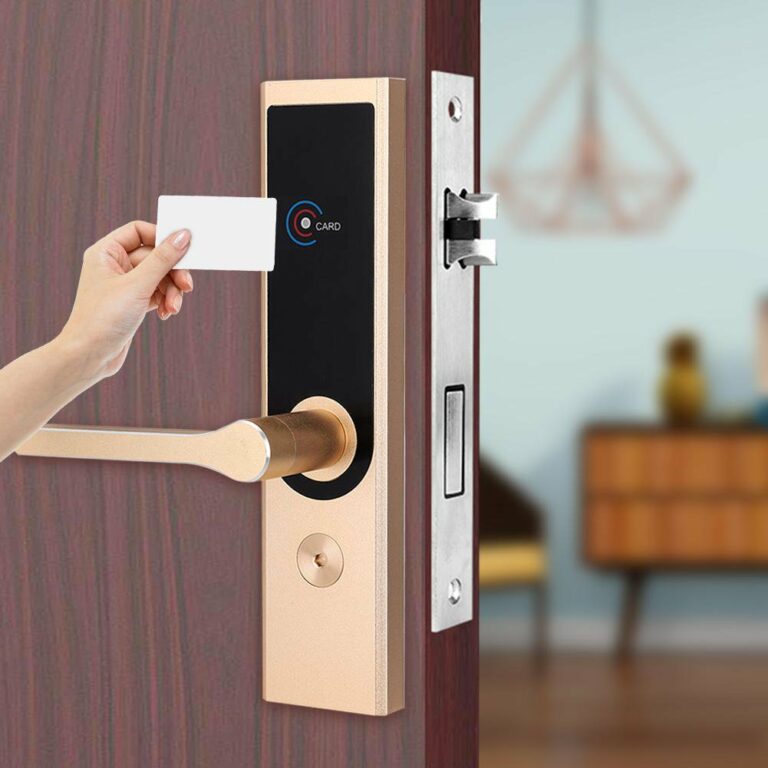5 Types of Hotel Door Locks and How to Become a Tech-Enabled Operation
The right hotel door lock system is not only essential to securing hotel rooms, but to securing guest satisfaction.
Increasingly, guests expect a tech-enabled stay and contactless experiences.
The trick is to find a way to give them that without spending a fortune on overhauling your current lock system.
In this article, we look at the types of hotel door locks on the market, assessing how effective they are at ensuring a frictionless guest check-in and reducing the workload of understaffed or inexperienced teams.
With insights from Axel Persson, who’s worked for Operto for five years providing consultation on access systems, we also explore how you can upgrade your hotel locks while protecting your profit margins.
How does a hotel door lock system work?
A hotel door lock system integrates your locks with your management tools so you can provide, oversee, and control access points throughout your hotel. Most locks today use pin codes, keycards, or smart technology with digital keys.
With Operto, the hotel door lock system can be broken down into three distinct areas:
- Access management
Your locks connect with a remotely managed access system, which is integrated to your PMS, operations management tools, and guest experience software via an all-in-one dashboard. - Guest access automation
We automate unique mobile keys and/or access codes for every stay and share these with your guests. - Guest experience
Guests use a branded web app and digital guidebook to be independent throughout the guest journey, from pre-stay to check-out.
We’ll explore how different types of locks work in more depth next, as well as how these solutions affect the guest experience, your management processes, and on-the-ground efficiency.
5 Types of hotel door lock systems
Here, we take a look at the five main types of hotel door lock, and consider some of the pros and cons of each.
1. Magstripe
A magnetic stripe (or magstripe) lock unlocks when a card with data that matches its stored information is swiped or inserted. This data is uploaded to the card from a centralized system at the front desk or by a check-in kiosk, and to the lock through either a wired or wireless connection.

Magstripe lock pros
- They’re easy to use
- They’re affordable to produce
- You can change the card data quickly each time a guest checks in
Magstripe lock cons
- The keycards can easily be demagnetized and stop working
- They don’t offer the same level of security as contactless solutions since cards are easily lost
- They may feel outdated to guests who’ve experienced digital access
2. RFID
RFID (radio frequency identification) locks work by matching their stored data and the data in a chip, which is typically in a card. Because RFID readers work via electromagnetic waves, they don’t need to make contact with the card—you just hold the card against or near the reader, and voilà.
These days, RFID locks often come with Bluetooth Low Energy (BLE) built-in. This means that you can facilitate keyless entry with a guest’s mobile phone. However, as we explore later, you still need a platform to manage this.
With Operto Guest, the process looks like this:
- Operto syncs with your PMS and digital locks
- When your guests make a booking, they’re sent a link to a branded web app
- From here, they can verify their identity and complete a security deposit
- Then, their automatically generated mobile key is activated based on check-in time


RFID lock pros
- Guests prefer touchless check-in
- RFID keycards are more durable than magstripe ones
- They’re highly secure
RFID lock cons
- They can be expensive
- Cards can easily be lost
3. Pin code
Pin code locks aren’t so common among hotels but, since there are tools available to integrate them with management and guest experience software, they’re a solution worth considering.
A good example of how to effectively implement pin code locks is Roomza, which we recently wrote about here.


Pin code lock pros
- They can be used in self check-in solutions
- You can automate codes quickly and easily with Operto (more on this later)
- They’re normally very durable
Pin code lock cons
- They can look clunky
- Hotel guests tend to prefer touchless options
- Manually programmed keypads are not very secure
4. BLE (Bluetooth Low Energy)
BLE (Bluetooth Low Energy) locks work by reading information transmitted via a Bluetooth signal. They can help you to meet modern guest expectations by making it possible for people to enter without a physical key. But upfront costs can be expensive, making it difficult for many boutique hotels to transition over.
With the latest cutting-edge technology, though, BLE connectivity is accessible even to small independent hotels. We explore this further in the next section.
BLE lock pros
- They offer the highest level of security by using encrypted algorithms plus the built-in biometric systems of mobile phones
- They improve the guest experience
- They reduce front-desk workload
BLE lock cons
- Some guests prefer an in-person check-in
- They come with higher upfront costs
5. Operto Boost
With Operto Boost, you can retrofit any lock to turn it into a BLE lock by inserting the Boost Smart Chip. By simply adding this technology to your existing hardware, you avoid the following issues:
- High costs. You won’t need to buy new commercial-grade locks or doors.
- Delays. You’ll avoid supply chain issues and consequent lengthy installation times. The process of implementing Boost is so easy you can even do it yourself.
- Complications. Axel explained to us that, “Fire codes may have changed in the time since you first installed your door and after installing a new lock, you’ll need to assess every part to ensure they meet new standards.”
The limits of BLE functionality
Installing BLE locks still isn’t a complete solution. You need software through which to manage and provide access.
“Most manufacturers provide only an unbranded app which doesn’t connect with your hotel in any way, provides no automation, and no real guest experience,” Axel explained.
By sending your guests a link to a generic app, you miss the opportunity to brand-engage them in the build-up to their stay. And by only providing room access, managed manually by staff, they’ll still depend on your team to guide them through arrival—not a crime by any means, but they won’t be fully independent, and it doesn’t address your staffing pressures.
With hotel management software like Operto Guest, on the other hand, you can:
- Cut lines at the front desk with a frictionless self check-in experience
- Use the branded web app to guide guests through ID verification and the security deposit process
- Respond to guest queries and concerns with two-way messaging
- Create customizable digital guidebooks with information about WiFi, parking, amenities, and more. These can also include smart buttons that link to add-on services.
Because Guest is part of an integrated tech stack, you can also access our team management and tech solutions in the same operating system. You can:
- Automate team calendars with information about occupancy
- Auto-generate tasks based on your team’s schedule
- Centralize team communications
- Manage integrations with other smart devices—for example, smart thermostats that automate energy-saving


Harnessing the power of BLE locks
Meeting modern guest expectations means becoming tech-enabled. Commercial-grade BLE locks offer the highest level of security and facilitate contactless check-in. But they’re also expensive—especially since you’ll need to implement them across all access points.
But with the latest technology, you can have a fully integrated system for automated processes, operational efficiency, and a contactless guest experience, without replacing any hardware.
To get the benefits of BLE hotel locks but without the prohibitive costs, you should:
- Upgrade your old hardware with Operto Boost
- Bring all your solutions together inside a single dashboard to maximize operational efficiency
- Enhance the guest experience with a seamless check-in process and digital guide
Turn existing locks into smart locks without the costs or hassle.
Learn more about Operto Boost.
Frequently asked questions about hotel door locks
What is a hotel door lock system?
Hotels can use electronic and digital door locks to secure their buildings. These will integrate with an online of offline access control system to allow hotel owners to provide access to guests and teams as they navigate through buildings and outdoor areas.
Why does your hotel need a door lock system?
Robust door locks are an essential part of any hotel’s security system. Well-integrated locks with BLE connectivity also facilitate contactless room access which boosts guest satisfaction, providing increased independence and less pressure on your staff.